If you are wondering why bugs and other pests pay your bathroom a visit, it’s because of all the moisture. And when we’re talking about the toilet seat, in particular, many people fail to clean it consistently and in detail. Flushing isn’t enough, since there is the residue left behind and that is enough to attract all the wrong guests.
Bright Side wants you to know that many pests can crawl into your house through your toilet and that there are ways to prevent this from happening.
1. Snakes
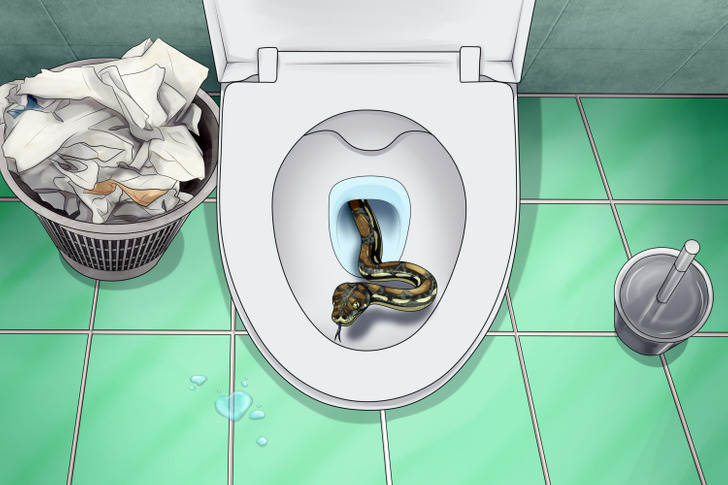
Snakes just love cool, wet, and dark places and that’s why your toilet pipes can be very intriguing to them. But, what drives them there in the first place is the sewer that has food remnants that they can feed on. When they are finished with their food in the sewer, they will look for a way out and the pipes are the easiest and quickest route. However, you shouldn’t be afraid if you live in a cold environment, since snakes will only sneak up in toilets in warm countries.
It’s usually harmless snakes that crawl through the pipes, like garden or tree snakes. That’s because these snakes are slimmer than venomous ones and can fit through the pipes. Although, some anacondas have appeared in people’s toilets in South America and Australia.
2. Rats
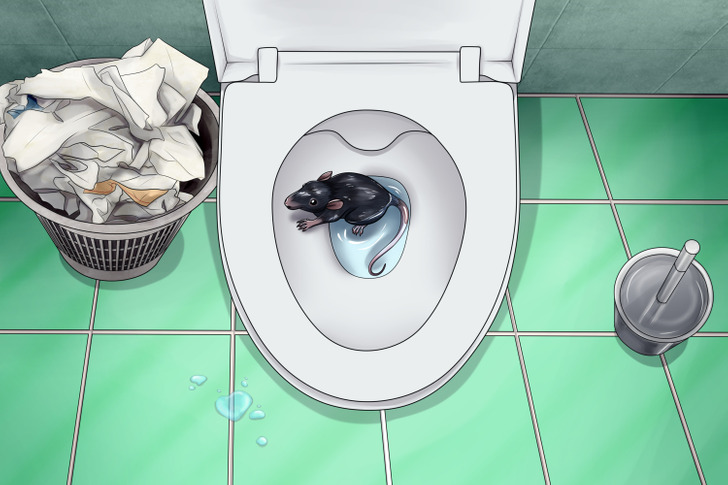
Like snakes, rats are also in constant pursuit of food and our pipes can be very appealing to them. In houses where the toilet and garbage disposal end up in the same pipes, rats are more likely to find a way in. And because their anatomy is very bendy, they can swim through the pipes and hold their breath for minutes before they need air.
So, it’s not just important to discard your food remnants in a trash bag but to also never flush food down the toilet. If there is no food in the pipes, rats won’t have any reason to try and enter your sewage system. You should also keep the toilet cover closed at all times and maybe install a rat guard. This allows water to exit the pipes whenever you flush, but nothing can come up in the opposite direction.
3. Spiders
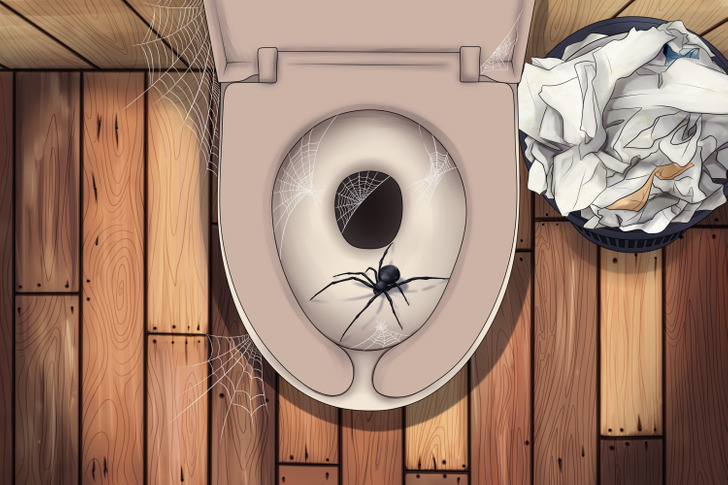
With spiders, things get a bit more complex, since they can’t swim in your pipes, but they can appear in your bathroom through another passage. And when they get in, they will probably sit outside the toilet seat. Only black widows will crawl inside the toilet and weave their web from side to side. But, that will happen only in an outdoor toilet that doesn’t have plumbing and that isn’t connected to a sewer system.
That’s where these venomous spiders thrive since there are many flies that they can catch for food. That’s also why you need to always check the seat thoroughly before using an outhouse toilet. Spiders, like the black widow, the brown recluse, and the hobo spider won’t have any trouble biting you.
4. Lizards
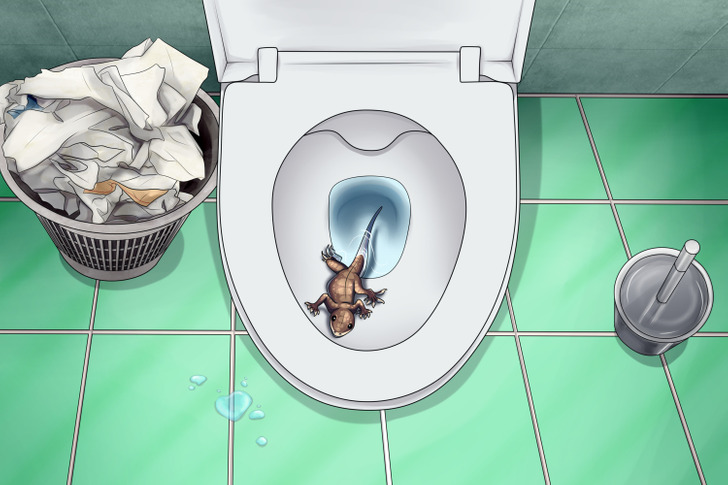
In the Southwest United States, lizards coming through the toilet pipes are a quite common occurrence. That’s because these creatures love water and they try to find food wherever they can. Crickets and other insects (like flies) can be found a lot in your toilet’s plumbing if it’s not kept decently clean. The lizards that can achieve this are usually small enough that they can fit through the pipes.
5. Possums
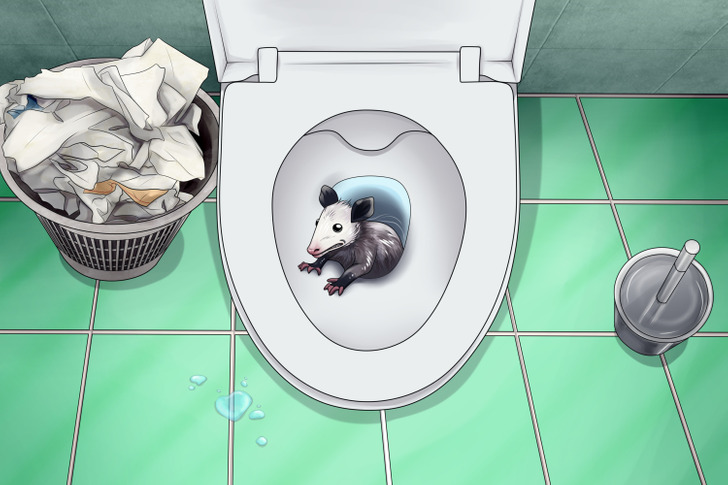
In 2008, a man was in his bathroom in Australia when he saw the water in the toilet gurgling. Moments later, a baby possum appeared and this is not the first time this has happened. On another occasion, a woman found a dead possum in her toilet. These unusual guests are excellent swimmers and can hold their breath for a long time — that’s why they can crawl into your toilet.
How to prevent and react to these occurrences
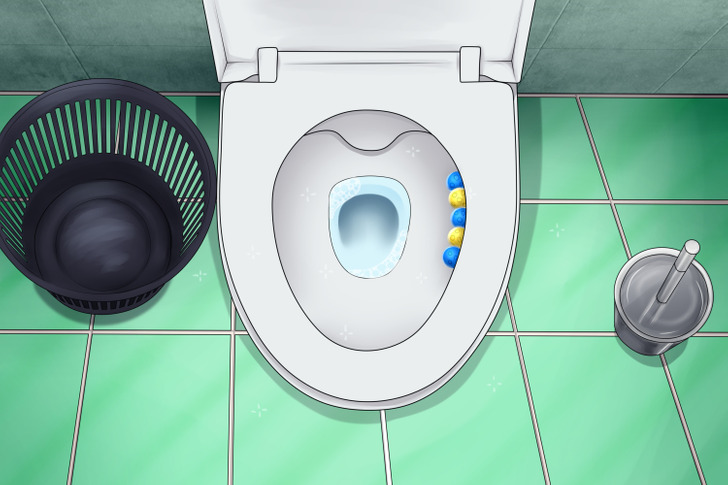
- Keep your toilet clean: This may sound obvious, but you really need to clean your toilet often and neatly. Disinfecting cleaners are perfect for that job and if you want something cheaper you can resort to white wine vinegar or baking soda. You can also get one of those fresheners that stick on the side of the toilet and release a nice smell every time you flush.
- Keep it dry: Most pests love humidity and that’s why they will be attracted to wet bathroom floors. So, it’s important to get rid of any standing water from the sink or the floor after you’ve taken a shower. If you notice any leaks in your plumbing, call a technician immediately and get them fixed.
- Clean your pipes naturally: In a bowl, add equal parts of sugar, water, vinegar, and 5-10 drops of dish soap. Mix all of this together and pour it down the toilet or in your bathroom sink. You can also pour some boiling water into the toilet.
- Call a pest control company: If you don’t have the time or courage to deal with pests yourself, call professionals and let them use their heavy cleaners. After that is done, you can occasionally throw water mixed with a cleaning solution down the drain to make sure no pest will climb up into the toilet.
Have you ever found an uninvited guest in your toilet — if so, what was it and how did you react?
My Husband Refused to Buy a New Washing Machine and Told Me to Wash Everything by Hand — Because He Promised His Mom a Vacation Instead

Six months postpartum, drowning in baby laundry, and exhausted beyond words, I thought my husband would understand when our washing machine broke. But instead of helping, he shrugged and said, “Just wash everything by hand—people did it for centuries.”
I never thought I’d spend this much time doing laundry.

A tired woman in a chair | Source: Pexels
Six months ago, I gave birth to our first baby. Since then, my life had turned into a never-ending cycle of feeding, changing diapers, cleaning, cooking, and washing. So much washing. Babies go through more clothes in a day than an entire football team.
On a good day, I washed at least eight pounds of tiny onesies, burp cloths, blankets, and bibs. On a bad day? Let’s just say I stopped counting.

A woman doing laundry | Source: Pexels
So when the washing machine broke, I knew I was in trouble.
I had just pulled out a soaking pile of clothes when it sputtered, let out a sad grinding noise, and died. I pressed the buttons. Nothing. I unplugged it, plugged it back in. Nothing.
My heart sank.
When Billy got home from work, I wasted no time.

A tired puzzled woman | Source: Pexels
“The washing machine is dead,” I said as soon as he stepped through the door. “We need a new one.”
Billy barely looked up from his phone. “Huh?”
“I said the washing machine broke. We need to replace it. Soon.”
He nodded absently, kicked off his shoes, and scrolled through his screen. “Yeah. Not this month.”

A man on his phone in his living room | Source: Pexels
I blinked. “What?”
“Not this month,” he repeated. “Maybe next month when I get my salary. Three weeks.”
I felt my stomach twist. “Billy, I can’t go three weeks without a washing machine. The baby’s clothes need to be cleaned properly every day.”

A couple having a serious talk | Source: Pexels
Billy sighed like I was asking for something unreasonable. He put his phone down and stretched his arms over his head. “Look, I already promised to pay for my mom’s vacation this month. She really deserves it.”
I stared at him. “Your mom’s vacation?”
“Yeah. She’s been babysitting for us. I thought it’d be nice to do something for her.”
Babysitting?

A shocked woman | Source: Pexels
I swallowed hard. His mother came over once a month. She sat on the couch, watched TV, ate the dinner I cooked, and took a nap while the baby slept. That wasn’t babysitting. That was visiting.
Billy kept talking like he hadn’t just dropped a bomb on me. “She said she needed a break, so I figured I’d cover her trip. It’s just for a few days.”
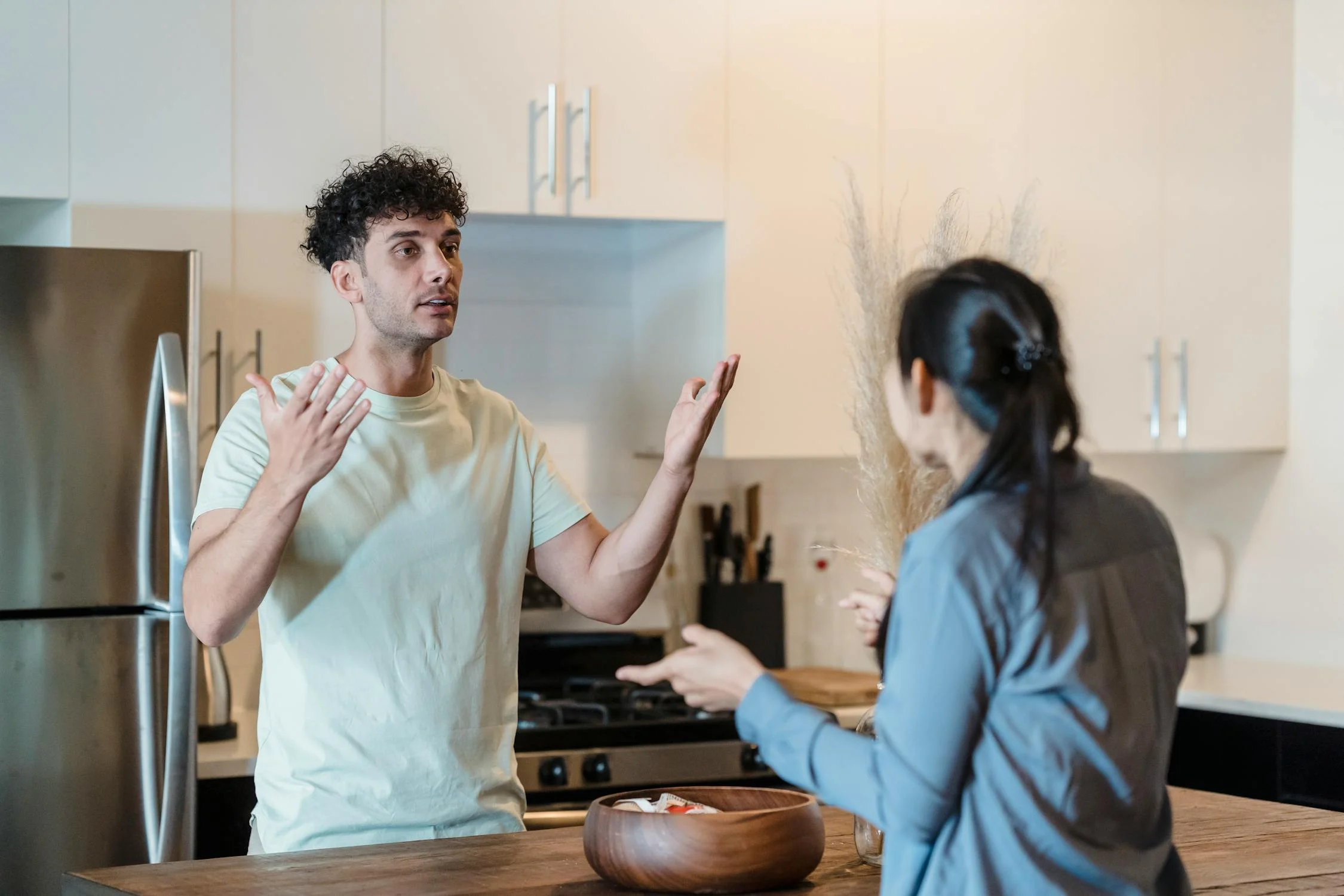
A man talking to his wife in his kitchen | Source: Pexels
I crossed my arms. “Billy, your mom doesn’t babysit. She comes over, eats, naps, and goes home.”
He frowned. “That’s not true.”
“Oh, really? When was the last time she changed a diaper?”
Billy opened his mouth, then shut it. “That’s not the point.”
I let out a sharp laugh. “Oh, I think it is.”
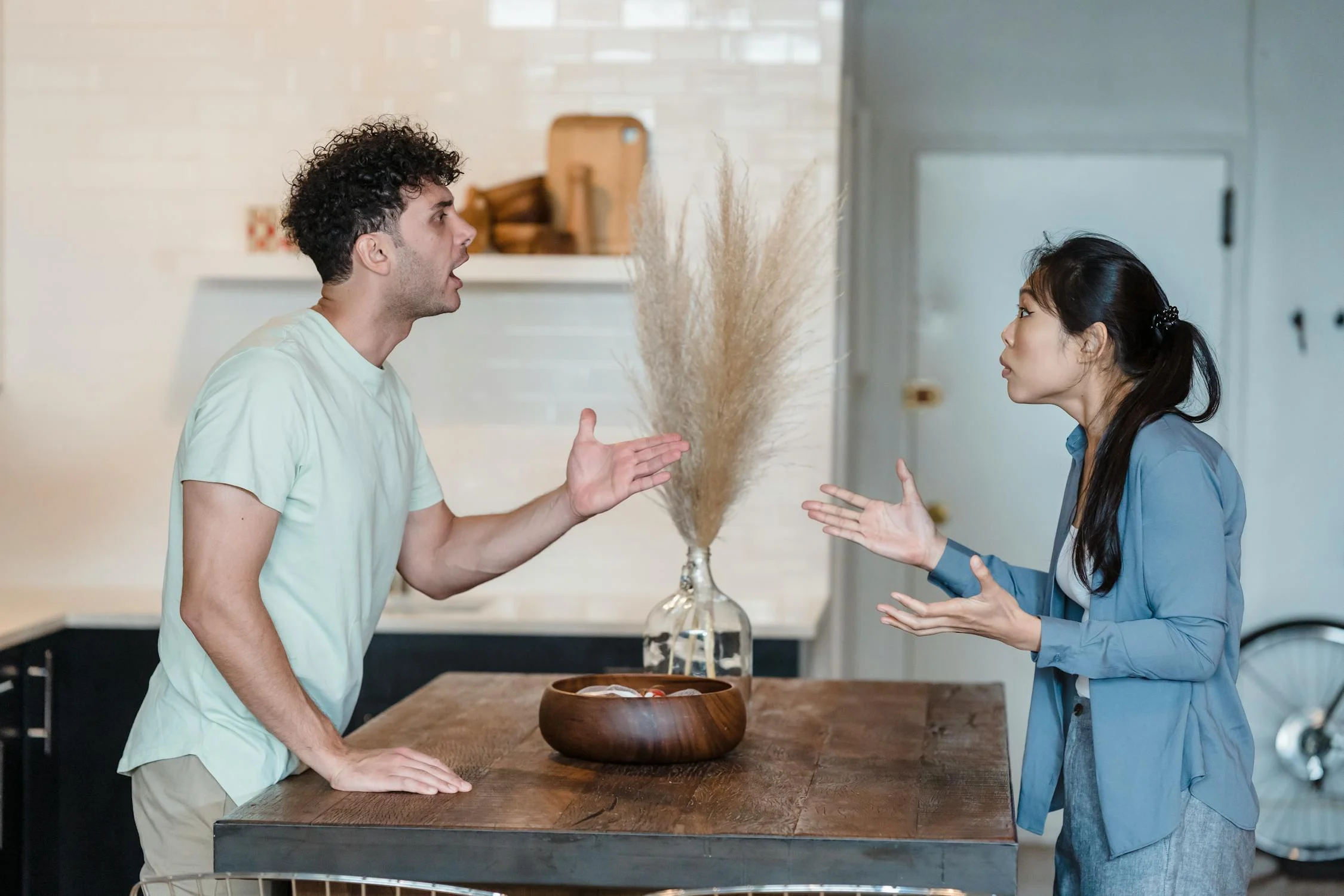
A couple arguing in their kitchen | Source: Pexels
He groaned, rubbing his face. “Look, can’t you just wash everything by hand for now? People used to do that for centuries. Nobody died from it.”
I stared at him, feeling my blood boil. Wash everything by hand. Like I wasn’t already drowning in work, exhausted, aching, and running on three hours of sleep a night.

An angry woman clutching her head | Source: Pexels
I took a slow, deep breath, my hands clenching into fists. I wanted to yell, to scream, to make him understand how unfair this was. But I knew Billy. Arguing wouldn’t change his mind.
I exhaled and looked at the pile of dirty clothes stacked by the door. Fine. If he wanted me to wash everything by hand, then that’s exactly what I’d do.
The first load wasn’t so bad.

A pile of clothes | Source: Pexels
I filled the bathtub with soapy water, dropped in the baby’s clothes, and started scrubbing. My arms ached, but I told myself it was temporary. Just a few weeks.
By the third load, my back was screaming. My fingers were raw. And I still had towels, bedsheets, and Billy’s work clothes waiting for me.

A tired woman sitting near a bathtub | Source: Midjourney
Every day was the same. Wake up, feed the baby, clean, cook, do laundry by hand, wring it out, hang it up. By the time I was done, my hands were swollen, my shoulders stiff, and my body exhausted.
Billy didn’t notice.
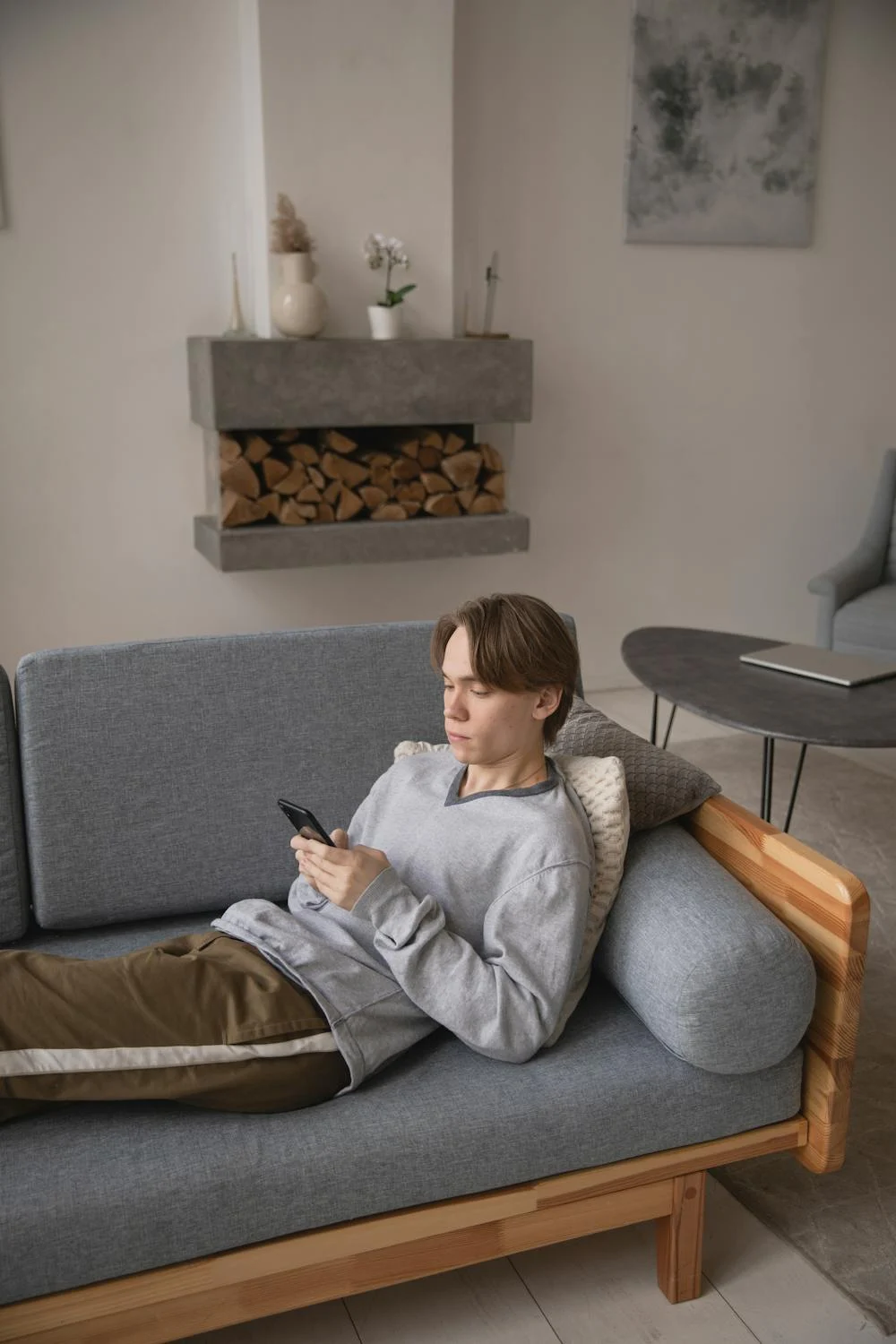
A bored man on a couch | Source: Pexels
He came home, kicked off his shoes, ate the dinner I cooked, and stretched out on the couch. I could barely hold a spoon, but he never once asked if I needed help. Never looked at my hands, red and cracked from hours of scrubbing.
One night, after I’d finished washing another pile of clothes, I collapsed onto the couch next to him. I winced as I rubbed my aching fingers.
Billy glanced at me. “What’s wrong with you?”

A tired woman on her couch | Source: Pexels
I stared at him. “What’s wrong with me?”
He shrugged. “You look tired.”
I let out a bitter laugh. “Gee, I wonder why.”
He didn’t even flinch. Just turned back to the TV. That was the moment something snapped inside me.

An annoyed woman in her kitchen | Source: Pexels
Billy wasn’t going to understand—not unless he felt the inconvenience himself. If he wanted me to live like a 19th-century housewife, then fine. He could live like a caveman.
So I planned my revenge.
The next morning, I packed his lunch as usual. Except instead of the big, hearty meal he expected, I filled his lunchbox with stones. Right on top, I placed a folded note.

A lunchbox filled with rocks | Source: Midjourney
Then I kissed his cheek and sent him off to work.
And I waited.
At exactly 12:30 PM, Billy stormed through the front door, red-faced and furious.
“What the hell have you done?!” he shouted, slamming his lunchbox onto the counter.
I turned from the sink, wiping my hands on a towel. “What do you mean, sweetheart?”

A laughing woman in her kitchen | Source: Midjourney
He flipped open the lid, revealing the pile of rocks. He grabbed the note and read it out loud.
“Men used to get food for their families themselves. Go hunt your meal, make fire with stones, and fry it.”
His face twisted in rage. “Are you out of your damn mind, Shirley? I had to open this in front of my coworkers!”
I crossed my arms. “Oh, so public humiliation is bad when it happens to you?”

A shouting man wearing glasses | Source: Pexels
Billy clenched his jaw. He looked like he wanted to yell, but for once, he didn’t have a comeback.
I crossed my arms and tilted my head. “Go on, Billy. Tell me how this is different.”
His jaw tightened. “Shirley, this is—this is just childish.”
I let out a sharp laugh. “Oh, I see. So your suffering is real, but mine is just me being childish?”

An angry woman lecturing her husband | Source: Pexels
He threw his hands in the air. “You could have just talked to me!”
I stepped forward, fire burning in my chest. “Talked to you? I did, Billy. I told you I couldn’t go three weeks without a washing machine. I told you I was exhausted. And you shrugged and told me to do it by hand. Like I was some woman from the 1800s!”

A woman turning away from her husband | Source: Pexels
His nostrils flared, but I could see the tiny flicker of guilt creeping in. He knew I was right.
I pointed at his lunchbox. “You thought I’d just take it, huh? That I’d wash and scrub and break my back while you sat on that couch every night without a care in the world?”
Billy looked away, rubbing the back of his neck.

A sad man clutching his head | Source: Pexels
I shook my head. “I’m not a servant, Billy. And I’m sure as hell not your mother.”
Silence. Then, finally, he muttered, “I get it.”
“Do you?” I asked.
He sighed, shoulders slumping. “Yeah. I do.”

A tired man rubbing his temples | Source: Pexels
I watched him for a long moment, letting his words settle. Then I turned back to the sink. “Good,” I said, rinsing off my hands. “Because I meant it, Billy. If you ever put your mother’s vacation over my basic needs again, you’d better learn how to start a fire with those rocks.”
Billy sulked for the rest of the evening.

An angry man in a hoodie | Source: Pexels
He barely touched his dinner. He didn’t turn on the TV. He sat on the couch, arms crossed, staring at the wall like it had personally betrayed him. Every now and then, he sighed loudly, like I was supposed to feel bad for him.
I didn’t.
For once, he was the one uncomfortable. He was the one who had to sit with the weight of his own choices. And I was perfectly fine letting him stew in it.

A woman reading a book on a couch | Source: Pexels
The next morning, something strange happened.
Billy’s alarm went off earlier than usual. Instead of hitting snooze five times, he actually got up. He got dressed quickly and left without a word.
I didn’t ask where he was going. I just waited.
That evening, when he came home, I heard it before I saw it—the unmistakable sound of a large box being dragged through the doorway.

A large box in the doorway | Source: Midjourney
I turned around and there it was. A brand-new washing machine.
Billy didn’t say anything. He just set it up, plugging in hoses, checking the settings. No complaints. No excuses. Just quiet determination.
When he finished, he finally looked up. His face was sheepish, his voice low.
“I get it now.”

A sorry man covering his face | Source: Pexels
I watched him for a moment, then nodded. “Good.”
He rubbed the back of his neck. “I, uh… should’ve listened to you sooner.”
“Yeah,” I said, crossing my arms. “You should have.”
He swallowed, nodded again, then grabbed his phone and walked away without argument or justification. Just acceptance. And honestly? That was enough.

A satisfied smiling woman | Source: Pexels
This work is inspired by real events and people, but it has been fictionalized for creative purposes. Names, characters, and details have been changed to protect privacy and enhance the narrative. Any resemblance to actual persons, living or dead, or actual events is purely coincidental and not intended by the author.
The author and publisher make no claims to the accuracy of events or the portrayal of characters and are not liable for any misinterpretation. This story is provided “as is,” and any opinions expressed are those of the characters and do not reflect the views of the author or publisher.



Leave a Reply